precipitation
Type of resources
Available actions
Topics
Keywords
Contact for the resource
Provided by
Years
Formats
Representation types
Update frequencies
status
Scale
Resolution
-
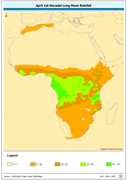
April 1st-Decadal Long Mean Rainfall. The APR1_LM grid data layer is comprised of 1152x1152 derivative raster precipitation features derived based on 8 kilometers data originally from EDC. 2nd and 3rd Decadal Rainfall from January to December are also available for download. Acronyms and Abbreviations: EDC - USGS EROS (Earth Resources Observation Systems) Data Center
-
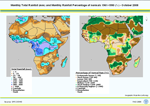
Maps on monthly total rainfall amount (in millimeters) and monthly rainfall percentage of normals 1961-1990 (in percentage) from August 2004 to October 2008 are available here for download for Southern Africa. Rainfall data are also available in GeoNetwork for the whole African continent and the following Regions : Northern Africa, Western Africa, and Eastern Africa. An interpolation method (Kriging) is applied to input data. Data input for rainfall maps are provided by Global Precipitation Climatology Centre (GPCC) operated by the Deutscher Wetterdienst (DWD, National Meteorological Service of Germany). GPCC First Guess Product, gauge-based gridded monthly precipitation data sets for the global land surface, at spatial resolutions of 1.0 x 1.0 degrees geographical latitude by longitude are used. The First Guess Product of the monthly precipitation anomaly is based on interpolated precipitation anomalies from about 6,000 stations worldwide. Data sources are synoptic weather observation data (SYNOP) received at DWD via the WMO Global Telecommunication System (GTS) and climatic mean (mainly 1961-1990) monthly precipitation totals at the same stations extracted from GPCC s global normals collection. An automatic-only quality-control (QC) is applied to these data. Since September 2003, GPCC First Guess monthly precipitation analyses are available within 5 days after end of an observation month.
-
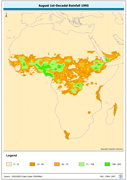
April 1st-Decadal Rainfall 1996. The APR1_95 grid data layer is comprised of 1152x1152 derivative raster precipitation features derived based on 8 kilometers data originally from EDC. 2nd and 3rd Decadal Rainfall from January to December is also available for download. Acronyms and Abbreviations: EDC - USGS EROS (Earth Resources Observation Systems) Data Center
-
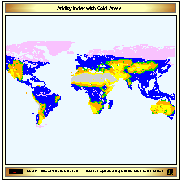
Aridity index (P/Pet) derived from IDRISI file with continuous data, reclassified into 6 classes (+ water bodies); The 6th class indicates cold climate derived from Thermal climates (Boreal and Arctic) received from IIASA in 2002. The IDRISI file with Aridity values was received by IIASA on February 2003.
-
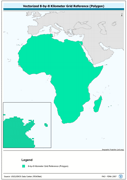
Vectorized 8-by-8 Kilometer Grid Reference (Polygon). The RFE_PY shapefile data layer is comprised of 471688 derivative calculated precipitation features derived based on 8 kilometers data originally from EDC. The layer provides nominal analytical/mapping at 1:35 000 000. Acronyms and Abbreviations: EDC - USGS EROS (Earth Resources Observation Systems) Data Center.
-

The new globally gridded Koeppen climatologies are based on climatological observations (temperature and precipitations) rasterized to grids of 0.5 x 0.5 degrees. They cover 4 different periods and are based on 3 different precipitation datasets. This leads to a total number of 12 rasterized Koeppen climatologies. The 4 different periods are: 1. 1951 - 2000 (all), 2. 1961 - 1990 (norm), 3. 1951 - 1975 (early), 4. 1976 - 2000 (late). Source: Mean annual cycles of temperature are always taken from the Climatic Research Unit (CRU, Mitchell and Jones, 2005). Precipitation is taken from GPCC VASClimO data, based on 9,343 stations that provide at least 90% coverage within 1951-2000 (Beck, Grieser and Rudolf, 2005). All different datasets are converted to the same 0.5 x 0.5 grid, which results from USGS gtopo30. Antarctica and Greenland are left out due to lack of data. For further information on the global climate grids please refer to the FAO Climpag website at http://www.fao.org/nr/climpag/globgrids/KC_classification_en.asp.
-
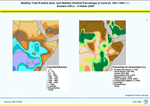
Maps on monthly total rainfall amount (in millimeters) and monthly rainfall percentage of normals 1961-1990 (in percentage) from August 2004 to October 2008 are available here for download for Eastern Africa. Rainfall data are also available in GeoNetwork for the whole African continent and the following Regions : Northern Africa, Western Africa, and Southern Africa. An interpolation method (Kriging) is applied to input data. Data input for rainfall maps are provided by Global Precipitation Climatology Centre (GPCC) operated by the Deutscher Wetterdienst (DWD, National Meteorological Service of Germany). GPCC First Guess Product, gauge-based gridded monthly precipitation data sets for the global land surface, at spatial resolutions of 1.0 x 1.0 degrees geographical latitude by longitude are used. The First Guess Product of the monthly precipitation anomaly is based on interpolated precipitation anomalies from about 6,000 stations worldwide. Data sources are synoptic weather observation data (SYNOP) received at DWD via the WMO Global Telecommunication System (GTS) and climatic mean (mainly 1961-1990) monthly precipitation totals at the same stations extracted from GPCC s global normals collection. An automatic-only quality-control (QC) is applied to these data. Since September 2003, GPCC First Guess monthly precipitation analyses are available within 5 days after end of an observation month.
-
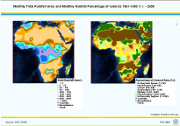
Maps on monthly total rainfall amount (in millimeters) and monthly rainfall percentage of normals 1961-1990 (in percentage) are available here for download from August 2004 to October 2008 for the African continent. Rainfall data are also available in GeoNetwork for the following Regions: Northern Africa, Western Africa, Eastern Africa and Southern Africa. An interpolation method (Kriging) is applied to input data. Data input for rainfall maps are provided by Global Precipitation Climatology Centre (GPCC) operated by the Deutscher Wetterdienst (DWD, National Meteorological Service of Germany). GPCC First Guess Product, gauge-based gridded monthly precipitation data sets for the global land surface, at spatial resolutions of 1.0 x 1.0 degrees geographical latitude by longitude are used. The First Guess Product of the monthly precipitation anomaly is based on interpolated precipitation anomalies from about 6,000 stations worldwide. Data sources are synoptic weather observation data (SYNOP) received at DWD via the WMO Global Telecommunication System (GTS) and climatic mean (mainly 1961-1990) monthly precipitation totals at the same stations extracted from GPCC s global normals collection. An automatic-only quality-control (QC) is applied to these data. Since September 2003, GPCC First Guess monthly precipitation analyses are available within 5 days after end of an observation month.
-
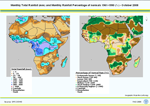
Maps on monthly total rainfall amount (in millimeters) and monthly rainfall percentage of normals 1961-1990 (in percentage) from August 2004 to October 2008 are available here for download for Northern Africa. Rainfall data are also available in GeoNetwork for the whole African continent and the following Regions : Western Africa, Eastern Africa and Southern Africa. An interpolation method (Kriging) is applied to input data. Data input for rainfall maps are provided by Global Precipitation Climatology Centre (GPCC) operated by the Deutscher Wetterdienst (DWD, National Meteorological Service of Germany). GPCC First Guess Product, gauge-based gridded monthly precipitation data sets for the global land surface, at spatial resolutions of 1.0 x 1.0 degrees geographical latitude by longitude are used. The First Guess Product of the monthly precipitation anomaly is based on interpolated precipitation anomalies from about 6,000 stations worldwide. Data sources are synoptic weather observation data (SYNOP) received at DWD via the WMO Global Telecommunication System (GTS) and climatic mean (mainly 1961-1990) monthly precipitation totals at the same stations extracted from GPCC s global normals collection. An automatic-only quality-control (QC) is applied to these data. Since September 2003, GPCC First Guess monthly precipitation analyses are available within 5 days after end of an observation month.
-
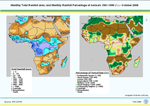
Maps on monthly total rainfall amount (in millimeters) and monthly rainfall percentage of normals 1961-1990 (in percentage) from August 2004 to October 2008 are available here for download for Western Africa. Rainfall data are also available in GeoNetwork for the whole African continent and the following Regions : Northern Africa, Western Africa, Eastern Africa and Southern Africa. An interpolation method (Kriging) is applied to input data. Data input for rainfall maps are provided by Global Precipitation Climatology Centre (GPCC) operated by the Deutscher Wetterdienst (DWD, National Meteorological Service of Germany). GPCC First Guess Product, gauge-based gridded monthly precipitation data sets for the global land surface, at spatial resolutions of 1.0 x 1.0 degrees geographical latitude by longitude are used. The First Guess Product of the monthly precipitation anomaly is based on interpolated precipitation anomalies from about 6,000 stations worldwide. Data sources are synoptic weather observation data (SYNOP) received at DWD via the WMO Global Telecommunication System (GTS) and climatic mean (mainly 1961-1990) monthly precipitation totals at the same stations extracted from GPCC s global normals collection. An automatic-only quality-control (QC) is applied to these data. Since September 2003, GPCC First Guess monthly precipitation analyses are available within 5 days after end of an observation month.
 FAO Map Catalog
FAO Map Catalog